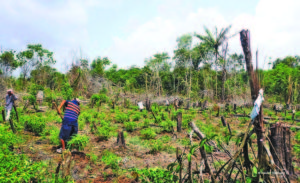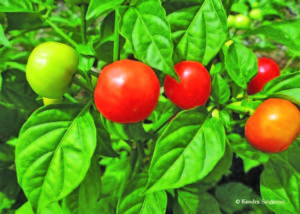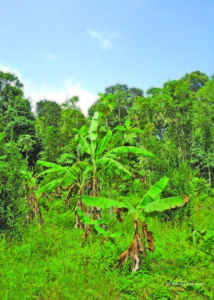By Kendra Seignoret
One of the interesting things about being able to stay a long time in one place is that you get to be a part of people’s everyday lives. And in doing so, it is more likely you will see parts of those lives that a ‘lightning strike’ tourist won’t.
While volunteering in Guyana, my group and I met a woman who had a little shop in Pakuri, a Lokono village, also known as St. Cuthbert’s Mission. She had a farm, located in the surrounding rainforest. About two months into our stay, she invited us to see it. I, for one, was delighted to receive the invitation – it was a way of life I knew nothing about and not to mention, it’s a farm in the middle of the rainforest!

The trip to the farm was a mini-epic adventure in itself. Tromping through the rainforest, getting covered and almost trapped by sucking mud, keeping an eye out for giant insects, traversing overgrown tracks, struggling to keep up with porters carrying way more things that we were; it almost felt like we were old-time explorers.
After traipsing through the jungle for over an hour, we came to a river, a tributary of the Mahaica River, which itself is a tributary of the Essequibo River. Here, we were introduced to the traditional dugout canoe. The canoe was about 5ft long and can fit four people and some gear. It’s quite shallow and it sits low in the water. It is quite the balancing act to climb in and out of the canoe. However, its position in the river meant that it was easy to stick my hand in the dark waters, trailing it behind me as I was ferried deeper into the rainforest. As it fit into my idea of adventure, I loved every minute of it.


Due to its isolated location, the rainforest farm had a fairly developed camping area – a small structure to escape the rain, some benches, hammocks, and a covered cooking area. The farm itself consisted primarily of fruit trees such as paw paw (also known as papaya) and citrus, ground fruits such as pineapple, and vegetables like pumpkin.
Wandering around the farm, it is very evident how labour intensive it is to upkeep without machinery. They also have to deal with produce destruction by animals and insects as well as possible theft by people. Since this farm is so spread out among the rainforest trees, much of the farm is unattended most of the time. As such, it is pretty easy for someone to steal what they want – though the farm’s isolation makes the prospect of human theft minimal.
A day at a rainforest farm can be surprisingly relaxing. I stuffed myself with food, I explored the farm and surrounding rainforest, I tried fishing for the first time (stick and string style), and I most definitely lounged in a hammock. I chatted with the farm owner about her idea of making her farm into an eco-lodge as the basics of it were already there. I personally love the idea.
It was fascinating to see how farming is done when one has no access to fancy tools and equipment. What I also realised was that this is the kind of place where you want to be when the world eventually goes to pot!
At the end of the day, we took the dugout canoe back to the village, slowly paddling our way through the tall trees and dense vegetation, listening to the birds call out to each other.
Guyana is definitely a country that could do well in eco-tourism and this farm is a prime example of this.
Kendra Seignoret is originally from Trinidad and Tobago, but currently lives in Canada. You can find more of her adventures on her blog Rusty Travel Trunk (www.rustytraveltrunk.com) or on Instagram @rustytraveltrunk



